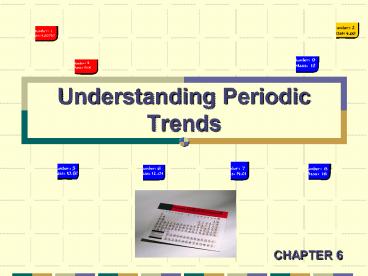Understanding Periodic Trends - PowerPoint PPT Presentation
1 / 18
Title: Understanding Periodic Trends
1
Understanding Periodic Trends
CHAPTER 6
2
Timeline
- 1829 J.W. Dobereiner
- Classification system in which elements are
grouped in triads - 3 elements with similar chemical properties
- Didnt work for all of the elements
- 1869-Russian Chemist, Dmitri Mendeleev
- Designed a Periodic Table 1869
- Elements are listed in order of increasing atomic
mass
3
Timeline continued
- 1913-British Scientist, Henry Moseley
- Designed the Modern Periodic Table
- Elements are listed in order of increasing atomic
- Based on Periodic Law physical chemical
- properties of elements are periodic functions
- of their atomic s
4
PERIODICITY
- There are general trends in the properties of
atoms and their ions. - These trends can be explained using the periodic
table and the electron configurations of the
atoms.
5
(No Transcript)
6
Atomic Radii
atom
- Half the distance between the
- nuclei in a molecule consisting
- of identical atoms
- Increases as you move down a group
- e- s are added to higher energy levels
- Shielding effect inner e-s shield the outer
- e-s from the attractive force of the nucleus
- Decreases as you move across a period
- Increasing of protons attract
- valence electrons more
- Stronger nuclear charge
D
I
7
Atomic Radii
D
I
8
Atomic Radii
- Practice
Which has a larger atomic radii?
9
Ionization Energy
- Energy needed to remove loosely held electron
from outer energy level
e
- Decreases as you move down a group
- Shielding effect inner e-s shield the outer e-s
from the attractive force of the nucleus - Bigger atom so it is easier to remove valence e-s
Nucleus cant hold onto e-s that are far
away
I
- Increases as you move across
- More valence e-s, more energy needed to
remove e-s
D
10
Ionization Energy in kJ/mol
D
I
11
Ionization Energy
- Practice
He or Xe? (kJ/mol)
Which has more ionization energy?
He Xe2372 kJ/mol 1170 kJ/mol
12
Ionic Size Cation() vs. Anion(-)
- Increases as you move down a group
- more energy levels greater the size
- Cations decrease as you move across a period
- Anions decrease as you move across a period
Cation (D)
Anion (D)
I
13
Ionic Size Cation() vs. Anion(-)
Cations lose electrons and get smaller
Anions gain electrons and get bigger
14
Ionic Size
- Practice
Which has a larger ionic size?
Li or Cs?
15
Electronegativity
- The ability of an atom to attract e-s to itself
when it is chemically combined with another
element. - Decreases as you move down a group
- Bigger the atom, the harder it is for the nucleus
to attract e-s - Increases as you move across a period
- More valence e-s, easier to gain e-s than lose
(MAGIC 8) - Noble gases are omitted because they dont form
many compounds
I
D
16
Electronegativity
I
D
17
Electronegativity
- Practice
Li or F?
Which is more electronegative?
18
PERIODICITY
Electronegativity Decreases
Atomic Radii Increases
Ionization Energy Decreases
Shielding Increases
Atomic Radii Decreases
Ionization Energy Increases
Electronegativity Increases
Shielding is Constant
Ionic Size (cation) Decreases
Ionic Size (anion) Decreases
PERIODICITY































